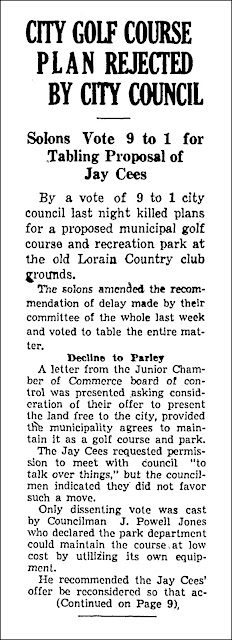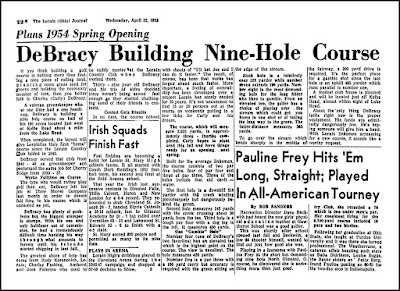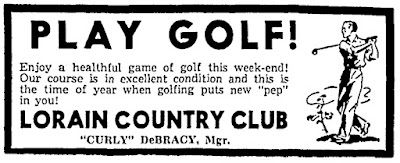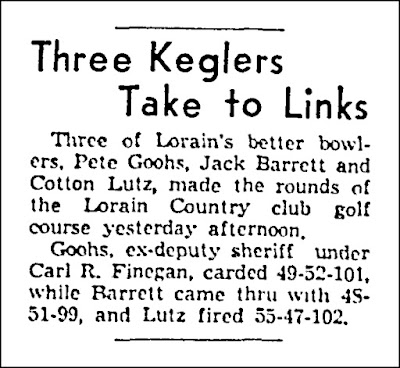 |
| April 4, 1943 |
By the spring of 1943, the option of playing golf at the Lorain Country Club was no longer being advertised in the
Lorain Journal. The City of Lorain was still mulling over the possibility of purchasing the golf course. The Lorain Country Club clubhouse, however, was still a popular nightclub, with regular ads in the paper.
In May, the Lorain City Council was not only tabling plans to buy the golf course, but – surprisingly – the Broadway Building as well, as noted in this article from May 4, 1943.
 |
| May 4, 1943 |
The Lorain Chamber of Commerce decided to get involved, forming a committee to study the possibility of the city making the purchase.
 |
| May 14, 1943 |
But – a year later – the city finally decided against buying the Lorain Country Club golf course and converting it to a municipal golf course and park. The article below from the June 20, 1944
Lorain Journal notes the various reasons why the proposal was rejected, mainly because of the expense of maintaining it, and the fact that there were already parks in Lorain that needed improvement.
Meanwhile, the clubhouse continued to host dance bands and offer fine dining and catering to its customers.
 |
| Feb. 3, 1945 |
But with the closing of the Lorain Country Club golf course, Lorain golfers needed a new local golf venue. So the Lorain Chamber of Commerce got involved again.
 |
| July 8, 1946 |
The Chamber determined the level of local interest in a new course, and ended up taking an option on land on Kolbe Road, bordering Jaeger and Oak Point Roads.
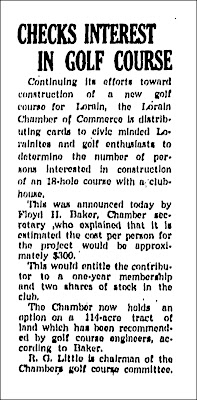 |
| Feb. 5, 1947 |
 |
| Feb. 20, 1947 |
Meanwhile, the Lorain Country Club nightclub was still doing big business in 1950 – and the City of Lorain was
still talking about buying the long-closed golf course.
 |
| March 8, 1950 |
 |
| Sept. 6, 1950 |
 |
| Sept. 8, 1950 |
 |
| Sept. 22, 1951 |
The proposed new golf course for Lorain championed by the Chamber of Commerce was still being talked about. The small item below appeared in the Lorain Journal on July 13, 1951. It noted that former Lorain Country Club operator and professional golfer "Curly" DeBracy had sold his tavern in Amherst so that he could purchase the acreage bordering Kolbe, Jaeger and Oak Point Roads.
"Curly" DeBracy followed through with his plan, as seen in this article from April 22, 1953.
Strangely, small items about the Lorain County Clubhouse appeared in the
Lorain Journal sports pages as filler during 1954.
 |
| May 20, 1954 |
 |
| July 14, 1954 |
As for the former Lorain Country Club golf course property, the photo below revealed that it was to be the location of a new allotment.
 |
| May 21, 1954 |
Sadly, in early December 1954, the story of the Lorain Country Club drew to a close with the fire that destroyed the clubhouse.
And "Curly" DeBracy's golf course would undergo an ownership change and emerge with a new name: Oak Hills Country Club.
 |
| Dec. 7, 1954 |
By the spring of 1955, the Sherwood Allotment was celebrating its Grand Opening – and the new Oak Hills Country Club would hold one of its own around July.
 |
| May 7, 1955 |
 |
| June 9, 1955 |
 |
| June 25, 1955 |
The 125th Anniversary of Lorain special edition of the Lorain Journal included a nice, comprehensive history of the Lorain Country Club. The article even mentions Curly DeBracy and Oak Hills Country Club (today's FoxCreek Golf & Racquet Club) as well.
Fittingly, the Lorain Country Club golf course lives on in memory. Its name continued to be attached via advertising to various housing sites on the West Side of Lorain, which was growing rapidly in the early 1960s.
 |
| June 20, 1960 |
 |
| April 29, 1961 |
























